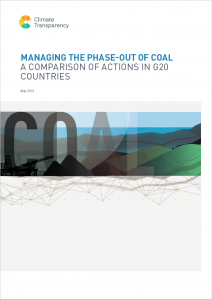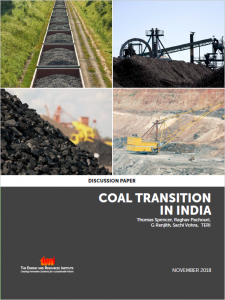According to the Intergovernmental Panel on Climate Change’s (IPCC’s) Special Report Global Warming of 1.5°C, a near-total reduction in the use of coal and other fossil fuels for electricity generation by 2050 is necessary if the temperature goal of the Paris Agreement is to be reached, with reductions of approximately two-thirds by 2030. The G20 countries are the biggest users and exporters of coal. Therefore, it is of particular importance that they embark on a process of phasing out coal.
In its new G20 coal brief, Climate Transparency compares the role of coal in G20 countries and their actions taken to phase out coal based on different indicators.
Role of coal in G20 countries
- About 30% of the primary energy supply of the G20 countries is derived from coal. In many G20 countries coal is the largest contributor to greenhouse gas emissions. Within the G20, South Africa (68%), China (64%), India (44%) and Australia (33%) have the highest coal share in domestic primary energy supply. It is even higher in their electricity mix.
- Absolute energy supply from coal in the G20 as a whole has been more or less constant between 2012 and 2017, with only a negligible decrease of 0.9%. While the share of renewables in the G20 energy mix increased, economic development and rising energy demand have driven up coal use simultaneously in nine G20 countries, particularly in Asia. In the United Kingdom, Italy, the European Union, France, the United States and Canada absolute coal supply decreased rapidly between 2012 and 2017. Reasons for this decrease vary from country to country: air quality and climate policies, coal phase-out commitments, carbon pricing, reduced costs of renewables and abundant supply of natural gas have played a role.
- Declining global coal demand will hit the largest G20 coal exporters the hardest – i.e. Australia (37% of global coal exports in 2017), Indonesia (16%), Russia (12%), the United States (9%) and South Africa (5%). Export revenues and related taxes are often used to subsidise domestic coal power prices, establish infrastructure in coal regions and employ workers. Coal exporters thus need to anticipate the transition and plan to manage it.
- Most G20 countries are currently constructing additional coal plants and/or are planning to do so, thus running the risk of stranded assets. The biggest additions in new coal capacity are planned (or are already under construction) in China (199 GW), India (94 GW), Turkey (37 GW) and Indonesia (27 GW). Turkey is to roughly triple its existing coal capacity and Indonesia to is to double it.
- G20 governments continue to provide at least US$39 billion of government support per year for the production of coal, including coal-fired power. This is through fiscal support measures (tax breaks and budgetary support), public finance and investment by state-owned mining and utility companies. This is an underestimate as it is not possible to capture or quantify many measures and projects. The largest overseas financiers of coal are China, Japan and South Korea. China’s public finance institutions have financed at least 27 GW of coal plants overseas (and in future will finance 24 GW), Japan’s 20 GW (future finance: 4 GW) and South Korea’s 10 GW (future finance: 3 GW).
G20 actions to phase out coal
- Canada, France, Italy and the United Kingdom lead the G20 with Paris-compatible plans for phasing out coal before or by 2030. In Germany, the Commission on Growth, Structural Change and Employment recommended phasing out coal by 2038 – a crucial achievement, but not aligned with the Paris Agreement. The G20 countries with the highest use of coal, highest coal exports or highest planned coal capacity are lacking any action to reduce coal production and use (Australia, Indonesia, Japan, South Korea, Turkey) and/or a long-term vision to phase out coal (India, China and South Africa).
- In advancing renewable energies, several of the G20’s big coal consumers or exporters –Australia, China, Indonesia, South Africa and Turkey – are rated low according to a rating of Climate Transparency’s Brown to Green Report 2018 based on the Allianz Climate & Energy Monitor. The combined scoring looks at the level of ambition of renewable energy targets against a pathway towards full decarbonisation in 2050 and at whether there is an adequate policy environment, including support policies and factors ensuring that projects are realised. Germany and India are the only G20 countries heavily reliant on coal that receive a high rating.
- In various G20 countries, the debate on just transition has begun to involve workers, trade unions, operators and the regions affected. There are national or regional governmental initiatives to learn from in Australia, Canada, China, the European Union, France, Germany, Indonesia, South Africa and the United States.
- The commitments of public finance institutions in G20 countries to end or restrict public spending for coal can be tracked via three categories: 1) Germany and the United Kingdom (and formerly the United States) are the only two G20 countries that announced that they would restrict coal financing in their role as shareholders of multilateral development banks (over and above the 2013 commitments of the World Bank Group, European Investment Bank and European Bank for Reconstruction and Development to restrict coal-fired power finance); 2) national development agencies and banks in Brazil, France, Germany, the United States and the United Kingdom are divesting from coal; 3) export credit agencies in all G20 OECD countries, except for Mexico, follow the OECD restrictions on financing for coalfired power plants – Canada’s, France’s and the United States’ export credit agency have in addition developed their own export policies.
Coal phase out in G20 countries – examples from India and Indonesia











